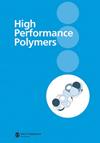Improving UV aging resistance by loading PDA on the surface of PBO fibers via Fe (III) coordination
IF 1.6
4区 化学
Q3 POLYMER SCIENCE
引用次数: 0
Abstract
Poly(p-phenylene-2,6-benzobisoxazole) (PBO) fiber is currently one of the best-performing organic fibers; however, its low UV aging resistance limits its use. To improve the UV aging performance of PBO fibers, a novel PBO-Fe-PDA fiber was created by depositing a biomimetic structure of polydopamine (PDA) on the surface of PBO fibers with the transition metal ion Fe通过铁(III)配位在 PBO 纤维表面载入 PDA 提高抗紫外线老化性能
聚(对苯基-2,6-苯并异噁唑)(PBO)纤维是目前性能最好的有机纤维之一,但其抗紫外线老化性能较低,限制了其使用。为了提高 PBO 纤维的抗紫外线老化性能,我们在 PBO 纤维表面沉积了仿生物结构的聚多巴胺(PDA),并以过渡金属离子 Fe3+ 作为活性中心,从而制成了新型 PBO-Fe-PDA 纤维。研究了 PBO-Fe-PDA 纤维的表面形态和元素组成。结果表明,Fe3+ 与恶唑环形成了配位键结构,PDA 成功地负载到了 PBO-Fe 纤维的表面。紫外老化后,PBO 纤维的结晶度和结晶取向明显降低,纤维内部的微晶发生滑移,纤维中的微空洞尺寸增大。因此,紫外线老化后 PBO 纤维的强度明显降低。而 PBO-Fe-PDA 纤维的抗紫外线老化能力则有所增强,这表现在紫外线老化后结晶度和结晶取向略有下降,纤维内部微空洞的尺寸增长明显减小。与 PBO 纤维相比,紫外线老化后 PBO-Fe-PDA 纤维的拉伸强度保持率提高了 93.13%,但纤维的初始强度没有改变。测试结果表明,这种表面改性方法简单易用,可显著延长 PBO 纤维的使用寿命。
本文章由计算机程序翻译,如有差异,请以英文原文为准。
求助全文
约1分钟内获得全文
求助全文
来源期刊

High Performance Polymers
化学-高分子科学
CiteScore
4.20
自引率
14.30%
发文量
106
审稿时长
1.2 months
期刊介绍:
Health Services Management Research (HSMR) is an authoritative international peer-reviewed journal which publishes theoretically and empirically rigorous research on questions of enduring interest to health-care organizations and systems throughout the world. Examining the real issues confronting health services management, it provides an independent view and cutting edge evidence-based research to guide policy-making and management decision-making. HSMR aims to be a forum serving an international community of academics and researchers on the one hand and healthcare managers, executives, policymakers and clinicians and all health professionals on the other. HSMR wants to make a substantial contribution to both research and managerial practice, with particular emphasis placed on publishing studies which offer actionable findings and on promoting knowledge mobilisation toward theoretical advances. All papers are expected to be of interest and relevance to an international audience. HSMR aims at enhance communication between academics and practitioners concerned with developing, implementing, and analysing health management issues, reforms and innovations primarily in European health systems and in all countries with developed health systems. Papers can report research undertaken in a single country, but they need to locate and explain their findings in an international context, and in international literature.
文献相关原料
公司名称
产品信息
阿拉丁
Dopamine hydrochloride (C8H12ClNO2)
阿拉丁
Iron (III) chloride hexahydrate
 求助内容:
求助内容: 应助结果提醒方式:
应助结果提醒方式:


